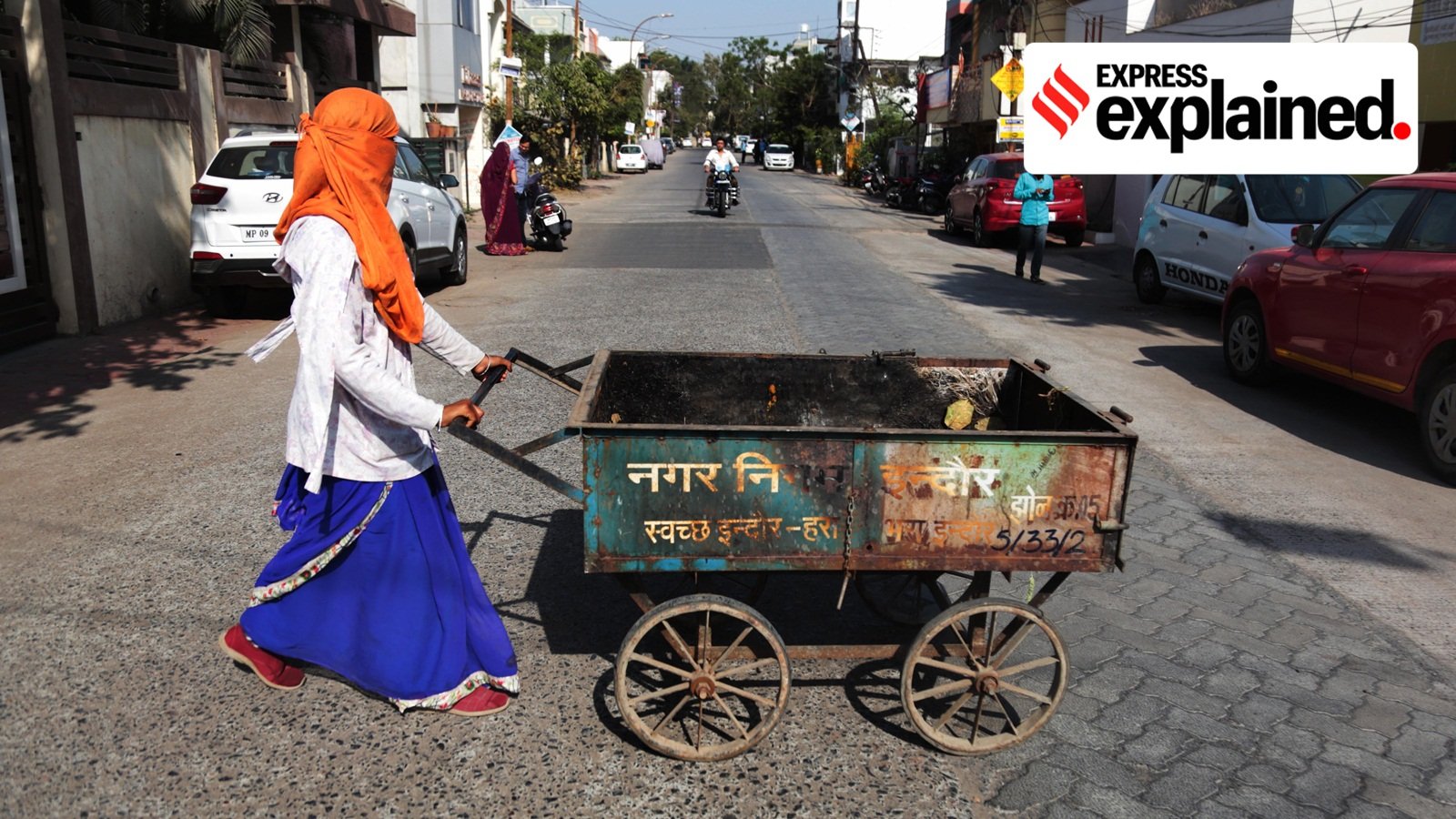[ad_1]
When the Awards first began in 2016, Indore ranked at number 25. How did the city leapfrog in the rankings in a year and how has it maintained its pole position? We explain what the ranking takes into account, and how a range of changes made to the city’s sanitation system were responsible for the improvement.
First, what the number 1 ranking means
The Union Housing and Urban Affairs Ministry presents the awards, which began as part of the Swachh Bharat Mission. The methodology for measuring cleanliness rests on two main criteria – citizen feedback and field assessment.
As the subject of sanitation comes under state governments, they are tasked with entering updated data on the Swachh Bharat Mission Management Information System (MIS). Then each of the areas being judged, say segregated garbage collection, will be “validated through Citizen Validation conducted in Residential and Commercial Areas in each ward on sampling basis.”
Questions related to waste collection and its frequency are then asked of citizens and validated accordingly. On-field assessors are to visit households/shops randomly to record responses. The criteria vary slightly as per the issue being surveyed. For example, to judge the kind of technical support provided to sanitation workers, the marking scheme takes into account whether Identity cards (IDs) are issued to informal waste pickers, if PPE kits are given, etc.

 A plastic sorting and recycling facility in Indore. (Express file photo by Amit Chakravarty)
A plastic sorting and recycling facility in Indore. (Express file photo by Amit Chakravarty)
Why does Indore keep ranking as the cleanest city?
Indore Municipal Corporation’s (IMC) consultant for the Swachh Bharat Abhiyan, Amit Dubey, told PTI, “A sustainable system of garbage collection, processing and disposal has been developed in Indore. The city’s consecutive success in the National Cleanliness Survey is based on this strong foundation.”
Indore targeted the various indicators mapped in the survey early on. A slew of measures included changes to the sanitation and waste collection system, as well as popularising these initiatives among citizens to build better habits around sanitation.
Segregation and disposal of waste: Terminating the private contract given for the collection and disposal of solid waste, Nagar Nigam took on this work and drew new strategies.
Santosh Tagore, then IMC Deputy Commissioner, told The Indian Express in 2017 that the routes of municipality garbage disposal vehicles were changed such that they directly collected waste — dry and wet separated — from the households. NGOs were also involved and went door-to-door to make people aware of handing over their garbage directly to the municipality vehicles, for a monthly charge for each household. In some instances, corporation workers refused to collect households’ garbage bags unless they had been segregated.
Initially, there was also some resistance from the local garbage collectors or ‘jagirs’ and the ragpickers as it disrupted the existing setup. In 2016, when 3,000 dustbins were installed every 500 metres for Rs 2.3 crore, at least 1,200 ragpickers lost their jobs. Eventually, the IMC absorbed 1,000 garbage collectors and most of the ragpickers, adding them to the force of 8,000 new ‘Safai Mitras’ who were tasked with collecting and transporting waste.
According to PTI, nearly 692 tonnes of wet waste, 683 tonnes of dry waste and 179 tonnes of plastic waste are now collected every day in the city under different categories. For this, around 850 specially designed vehicles are employed, having different compartments for bio-waste items like diapers and sanitary napkins. The waste from households in the city is collected after segregation under six categories at the doorstep.
Next was the issue of legacy waste, collected over the years and left untreated. In a bid to meet the goals of the survey, the clearing and treating of nearly 13 lakh metric tonnes of waste at the Devguradiya ground was accomplished in just about six months. “For a five-star rating in Swachh Bharat, one of the criteria is that 75 per cent of the waste be treated at the dumping site,” Asheesh Singh, Indore’s then municipal commissioner, told The Indian Express in 2019.
Once segregated waste started coming in, funds were taken from the Smart Cities Mission, SBM and IMC’s property tax kitty to construct 10 transfer stations (each costing Rs 4 crore) to collect waste before it was transported to the dumping ground. While the wet waste was entirely converted into compost and sold by the IMC, a new treatment plant was set up in 2016 at Devguradiya to tackle dry waste.
Installing new toilets, dustbins: The NGOs also did the groundwork for identifying areas in the city in need of urinals and toilets to tackle the challenge of open defecation – also checked under the survey.
“Efforts were made to identify individual households, number of families and their requirements, especially in slums and the areas near the Railway line, for the provision of single-household or community toilets – which were constructed and are now being used”, said Tagore.
Around 1,000 free dustbins were distributed to vehicle owners to encourage them to not throw waste out of windows.
Building habits among citizens: Former Mayor Malini Gaud earlier told The Indian Express in 2018 that the turnaround can also be attributed to people’s participation in the campaign. In a year, she held about 400 meetings of citizens and administered the oath of cleanliness to more than four lakh people.
The IMC also issued spot fines from Rs 250 to Rs 500 against people spitting on roads, urinating in the open, or littering. “Other efforts to deter habitual offenders haven’t worked in the past. We hope this public shaming will work as a deterrent,” the Mayor had said while announcing a plan to publish names of offenders in newspapers and broadcasting them over radio. On several occasions, she stepped out of her official vehicle to fine offenders personally.
[ad_2]
Source link






